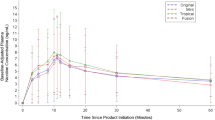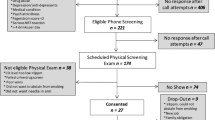Abstract
Rationale
Tobacco products are very addictive, partly because they contain nicotine which is reinforcing, but also because they include appealing aromas and tastes. Flavor additives are such sensory stimuli which enhance attractiveness, as well as use and abuse of tobacco and vaping products. Yet, the interaction between these flavor additives and nicotine remains poorly understood.
Objectives
We want to understand how flavors may reduce nicotine’ aversive taste and how it may enhance its voluntary oral self-administration in mice.
Methods
We first studied the effect of flavor additives on nicotine solution palatability in a free bottle choice paradigm. Second, we investigated the effect of vanilla flavoring on the different stages of nicotine (40 μg/ml) oral self-administration in mice.
Results
We show that adding flavors increase nicotine palatability and facilitate acquisition and maintenance of oral self-administration when compared to nicotine-alone group. Mice adapt their operant behavior depending on changes in nicotine concentration. All mice reinstate nicotine seeking upon presentation of associated cues. Nevertheless, vanilla-flavored nicotine was not more reinforcing than vanilla-flavored water which was reinforcing enough to drive similar operant response rates.
Conclusions
Flavor additives increase nicotine oral consumption and help maintaining operant behavior in mice. Moreover, flavors can be very attractive and can have high reinforcing value by themselves. Thus, it is crucial that the investigation on how taste signals play an important role in modulating oral nicotine intake in rodent models remains explored.








Similar content being viewed by others
References
Ayo-Yusuf OA, Agaku IT (2015) The association between smokers’ perceived importance of the appearance of cigarettes/cigarette packs and smoking sensory experience: a structural equation model. Nicotine Tob Res 17(1):91–97
Barret ST, Bevins RA (2013) Nicotine enhances operant responding for qualitatively distinct reinforcers under maintenance and extinction conditions. Pharmacol Biochem Behav 114–115:9–15
Biswas L, Harrison E, Gong Y, Avusula R, Lee J, Zhang M, Rousselle T, Lage J, Liu X (2016) Enhancing effect of menthol on nicotine self-administration in rats. Psychopharmacology 233(18):3417–3427
Chaudhri N, Caggiula AR, Donny EC, Booth S, Gharib M, Craven L, Palmatier MI, Liu X, Sved AF (2006a) Operant responding for conditioned and unconditioned reinforcers in rats is differentially enhanced by the primary reinforcing and reinforcement-enhancing effects of nicotine. Psychopharmacology 189(1):27–36
Chaudhri N, Caggiula AR, Donny EC, Palmatier MI, Liu X, Sved AF (2006b) Complex interactions between nicotine and nonpharmacological stimuli reveal multiple roles for nicotine in reinforcement. Psychopharmacology 184(3–4):353–366
Chaudhri N, Caggiula AR, Donny EC, Booth S, Gharib M, Craven L, Palmatier MI, Liu X, Sved AF (2007) Self-administered and noncontingent nicotine enhance reinforced operant responding in rats: impact of nicotine dose and reinforcement schedule. Psychopharmacology 190(3):353–362
Clemens KJ, Caille S, Cador M (2010) The effects of response operandum and prior food training on intravenous nicotine self-administration in rats. Psychopharmacology 211(1):43–54
Cohen A, Koob GF, George O (2012) Robust escalation of nicotine intake with extended access to nicotine self-administration and intermittent periods of abstinence. Neuropsychopharmacology 37(9):2153–2160
Collins AC, Pogun S, Nesil T, Kanit L (2012) Oral nicotine self-administration in rodents. J Addict Res Ther Suppl 2:004
Cooper SY, Akers AT, Henderson BJ (2021) Flavors enhance nicotine vapor self-administration in male mice. Nicotine Tob Res 23(3):566–572
Dahl M, Erickson RP, Simon SA (1997) Neural responses to bitter compounds in rats. Brain Res 756(1–2):22–34
Enoch MA, Harris CR, Goldman D (2001) Does a reduced sensitivity to bitter taste increase the risk of becoming nicotine addicted? Addict Behav 26(3):399–404
Grieder TE, Herman MA, Contet C, Tan LA, Vargas-Perez H, Cohen A, Chwalek M, Maal-Bared G, Freiling J, Schlosburg JE, Clarke L, Crawford E, Koebel P, Repunte-Canonigo V, Sanna PP, Tapper AR, Roberto M, Kieffer BL, Sawchenko PE, Koob GF, van der Kooy D, George O (2014) VTA CRF neurons mediate the aversive effects of nicotine withdrawal and promote intake escalation. Nat Neurosci 17(12):1751–1758
Grimm JW, Ratliff C, North K, Barnes J, Collins S (2012) Nicotine increases sucrose self-administration and seeking in rats. Addict Biol 17(3):623–633
Gyekis JP, Dingman MA, Revitsky AR, Bryant BP, Vandenbergh DJ, Frank ME, Blizard DA (2012) Gustatory, trigeminal, and olfactory aspects of nicotine intake in three mouse strains. Behav Genet 42(5):820–829
Harrell MB, Loukas A, Jackson CD, Marti CN, Perry CL (2017a) Flavored tobacco product use among youth and young adults: what if flavors didn’t exist? Tob Regul Sci 3(2):168–173
Harrell MB, Weaver SR, Loukas A, Creamer M, Marti CN, Jackson CD, Heath JW, Nayak P, Perry CL, Pechacek TF, Eriksen MP (2017b) Flavored e-cigarette use: characterizing youth, young adult, and adult users. Prev Med Rep 5:33–40
Harris AC, Muelken P, Swain Y, Palumbo M, Jain V, Goniewicz ML, Stepanov I, LeSage MG (2019) Non-nicotine constituents in e-cigarette aerosol extract attenuate nicotine’s aversive effects in adolescent rats. Drug Alcohol Depend 203:51–60
Krusemann EJZ, Boesveldt S, de Graaf K, Talhout R (2019a) An e-liquid flavor wheel: a shared vocabulary based on systematically reviewing e-liquid flavor classifications in literature. Nicotine Tob Res 21(10):1310–1319
Krusemann EJZ, Lasschuijt MP, de Graaf C, de Wijk RA, Punter PH, van Tiel L, Cremers J, van de Nobelen S, Boesveldt S, Talhout R (2019b) Sensory analysis of characterising flavours: evaluating tobacco product odours using an expert panel. Tob Control 28(2):152–160
Lee LY, Gerhardstein DC, Wang AL (1985) Burki NK (1993) Nicotine is responsible for airway irritation evoked by cigarette smoke inhalation in men. J Appl Physiol 75(5):1955–1961
Lenoir M, Kiyatkin EA (2011) Critical role of peripheral actions of intravenous nicotine in mediating its central effects. Neuropsychopharmacology 36(10):2125–2138
Morean ME, Butler ER, Bold KW, Kong G, Camenga DR, Cavallo DA, Simon P, O’Malley SS, Krishnan-Sarin S (2018) Preferring more e-cigarette flavors is associated with e-cigarette use frequency among adolescents but not adults. PLoS ONE 13(1):e0189015
Nesil T, Kanit L, Collins AC, Pogun S (2011) Individual differences in oral nicotine intake in rats. Neuropharmacology 61(1–2):189–201
Nesil T, Narmeen S, Bakhti-Suroosh A, Lynch WJ (2019) Effect of menthol on nicotine intake and relapse vulnerability in a rat model of concurrent intravenous menthol/nicotine self-administration. Psychopharmacology 236(4):1219–1232
Ogawa K, Tashima A, Sadakata M, Morinaga O (2018) Appetite-enhancing effects of vanilla flavours such as vanillin. J Nat Med 72(3):798–802
Palmatier MI, Lantz JE, O’Brien LC, Metz SP (2013) Effects of nicotine on olfactogustatory incentives: preference, palatability, and operant choice tests. Nicotine Tob Res 15(9):1545–1554
Palmatier MI, O’Brien LC, Hall MJ (2012) The role of conditioning history and reinforcer strength in the reinforcement enhancing effects of nicotine in rats. Psychopharmacology 219(4):1119–1131
Palmatier MI, Smith AL, Odineal EM, Williams EA, Sheppard AB, Bradley CA (2020) Nicotine self-administration with tobacco flavor additives in male rats. Nicotine Tob Res 22(2):224–231
Patten T, De Biasi M (2020) History repeats itself: role of characterizing flavors on nicotine use and abuse. Neuropharmacology 177:108162
Perkins KA, Karelitz JL, Boldry MC (2017) Nicotine acutely enhances reinforcement from non-drug rewards in humans. Front Psychiatry 8:65
Rose JE (2006) Nicotine and nonnicotine factors in cigarette addiction. Psychopharmacology 184(3–4):274–285
Shalev U, Grimm JW, Shaham Y (2002) Neurobiology of relapse to heroin and cocaine seeking: a review. Pharmacol Rev 54(1):1–42
Smith A, Roberts DC (1995) Oral self-administration of sweetened nicotine solutions by rats. Psychopharmacology 120(3):341–346
Soule EK, Lopez AA, Guy MC, Cobb CO (2016) Reasons for using flavored liquids among electronic cigarette users: a concept mapping study. Drug Alcohol Depend 166:168–176
Vandaele Y, Noe E, Cador M, Dellu-Hagedorn F, Caille S (2018) Attentional capacities prior to drug exposure predict motivation to self-administer nicotine. Psychopharmacology 235(7):2041–2050
Vogel EA, Prochaska JJ, Ramo DE, Andres J, Rubinstein ML (2019) Adolescents’ e-cigarette use: increases in frequency, dependence, and nicotine exposure over 12 months. J Adolesc Health 64(6):770–775
Wickham RJ, Nunes EJ, Hughley S, Silva P, Walton SN, Park J, Addy NA (2018) Evaluating oral flavorant effects on nicotine self-administration behavior and phasic dopamine signaling. Neuropharmacology 128:33–42
Xu J, Xu H, Liu Y, He H, Li G (2015) Vanillin-induced amelioration of depression-like behaviors in rats by modulating monoamine neurotransmitters in the brain. Psychiatry Res 225(3):509–514
Zhang M, Harrison E, Biswas L, Tran T, Liu X (2018) Menthol facilitates dopamine-releasing effect of nicotine in rat nucleus accumbens. Pharmacol Biochem Behav 175:47–52
Zhu SH, Sun JY, Bonnevie E, Cummins SE, Gamst A, Yin L, Lee M (2014) Four hundred and sixty brands of e-cigarettes and counting: implications for productregulation. Tob Control 23(Suppl 3):iii3–iii9
Acknowledgements
The authors thank Yoan Salafranque for the care provided to the mice during the experiments.
Funding
This study was supported by the Centre National de la Recherche Scientifique, the University of Bordeaux and Region Aquitaine and Institut National du Cancer (INCa 2019–016 to SC). ST was supported by the “Ministère de la Recherche et de l’Enseignement Supérieur”.
Author information
Authors and Affiliations
Corresponding author
Ethics declarations
Competing interests
The authors declare no competing interest.
Additional information
Publisher’s note
Springer Nature remains neutral with regard to jurisdictional claims in published maps and institutional affiliations.
Supplementary Information
Below is the link to the electronic supplementary material.
Fig. S1
Saccharin pretraining: oral self-administration of saccharin 0.1% solution. Performances are given with respect to the mice distribution during nicotine oral self-administration: vanilla 1% (grey bars and dots, n = 11), nicotine + vanilla 1% (black bars and dots, n = 12) and nicotine (white bars and dots, n = 12). a Number active and inactive nose-pokes (average over the last 3 sessions) and b number of rewards on the last day of training on FR2 schedule of reinforcement. *p < 0.05 main effect operant responding. All data are expressed as mean ± SEM (DOCX 7078 kb)
Fig. S2
Number of inactive nose-poke visits at different steps of nicotine oral self-administration for vanilla 1% (grey bars and dots, n = 11), nicotine + vanilla 1% (black bars and dots, n = 12), and nicotine (white bars and dots, n = 12) groups. Visits during a acquisition of fixed ratio schedules, b nicotine dose-response curve, and c progressive ratio test. *p < 0.05 Tukey multiple comparisons on groups. All data are expressed as mean ± SEM (DOCX 7658 kb)
Rights and permissions
About this article
Cite this article
Tannous, S., Darlot, F., Cador, M. et al. Flavor additives facilitate oral self-administration of nicotine solution in mice. Psychopharmacology 238, 2235–2247 (2021). https://doi.org/10.1007/s00213-021-05848-1
Received:
Accepted:
Published:
Issue Date:
DOI: https://doi.org/10.1007/s00213-021-05848-1




